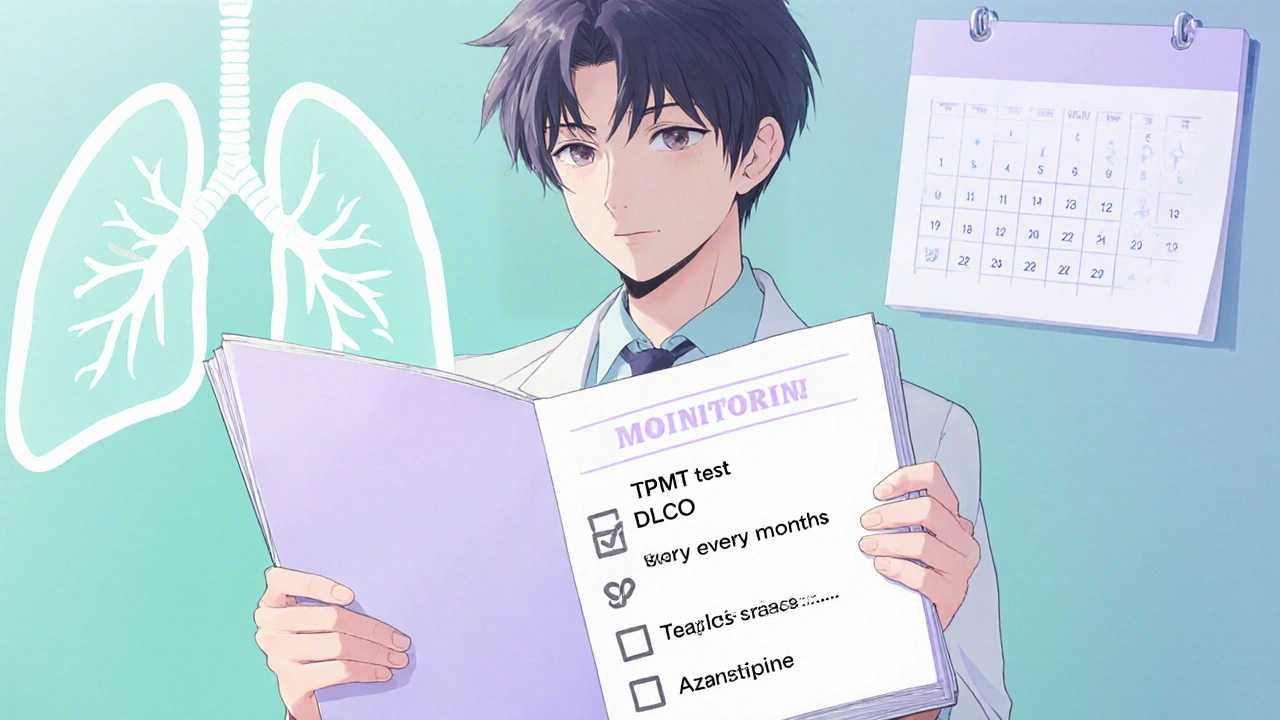Azathioprine Pulmonary Fibrosis Risk Calculator
Personal Risk Assessment
This calculator estimates your risk of developing drug-induced pulmonary fibrosis while taking azathioprine based on key clinical factors. Results are for informational purposes only and should not replace professional medical advice.
Estimated Risk Level
Did you know that up to 1 in 100 patients on Azathioprine develop some form of drug‑induced lung injury each year? That number may sound small, but for the people affected it can mean life‑changing breathlessness and, in rare cases, irreversible scarring.
Key Takeaways
- Azathioprine is an immunosuppressive drug used for autoimmune disorders, but it can rarely trigger pulmonary fibrosis.
- Early symptoms include dry cough, unexplained fatigue, and shortness of breath on mild exertion.
- Regular monitoring-lung function tests, chest CT scans, and TPMT enzyme testing-dramatically lowers the chance of severe damage.
- If risk factors are present, clinicians may switch to alternatives such as mycophenolate or methotrexate.
- Patients should never stop or change dosage without medical advice; a structured monitoring plan is essential.
What is Azathioprine?
Azathioprine is an immunosuppressive medication commonly prescribed for autoimmune conditions like rheumatoid arthritis and inflammatory bowel disease. It works by interfering with DNA synthesis in rapidly dividing immune cells, thereby dampening the body’s overactive response. Because it targets the very cells that cause inflammation, physicians often choose it as a long‑term maintenance drug.
Typical dosages range from 1 to 3 mg/kg per day, adjusted based on blood levels of the metabolite 6‑mercaptopurine and the activity of the enzyme thiopurine methyltransferase (TPMT). Low TPMT activity can cause drug accumulation and increase the likelihood of both hepatic and pulmonary toxicity.
Understanding Pulmonary Fibrosis
Pulmonary Fibrosis is a progressive lung disease characterized by scarring of lung tissue, leading to shortness of breath and reduced oxygen exchange. The scar tissue, called fibrosis, stiffens the lungs and makes it harder for oxygen to pass into the bloodstream. While many cases are idiopathic, drug‑induced fibrosis accounts for a measurable share of new diagnoses.
Symptoms often start subtly: a persistent dry cough, mild fatigue, and a feeling of “tightness” in the chest. As fibrosis progresses, even simple tasks like climbing stairs become exhausting.
How Azathioprine Can Trigger Lung Damage
Several mechanisms explain why azathioprine may harm the lungs:
- Metabolic toxicity: In patients with deficient TPMT activity, excess 6‑mercaptopurine generates reactive metabolites that can injure alveolar cells.
- Immune modulation: By suppressing normal immune surveillance, azathioprine may allow low‑grade infections or inflammatory processes to go unchecked, eventually leading to fibrosis.
- Direct cytotoxicity: High cumulative doses (>150 mg/day for extended periods) have been linked to interstitial lung disease in case‑control studies.
Risk factors include:
- Pre‑existing lung disease (asthma, COPD, prior interstitial pneumonitis)
- Low TPMT activity (<10 U/mL)
- Concurrent use of other cytotoxic drugs such as cyclophosphamide
- Smoking history
Patients with any of these factors should undergo stricter monitoring from the start of therapy.

Spotting Early Warning Signs
Because pulmonary fibrosis develops slowly, a proactive approach is essential. Ask yourself:
- Do I have a new, dry cough that won’t go away?
- Am I feeling unusually short of breath after walking a short distance?
- Is my energy level dropping without a clear reason?
If you answer “yes” to any of these, bring it to your clinician’s attention immediately. The following tests help confirm early disease:
- Lung function tests (spirometry and DLCO): A drop in diffusing capacity can be the first objective sign.
- Chest CT scan: High‑resolution images reveal subtle ground‑glass opacities before they appear on a plain X‑ray.
- Blood biomarkers: Elevated KL‑6 or surfactant protein D are emerging indicators of interstitial lung injury.
Monitoring Strategies to Reduce Risk
Integrating regular checks into your treatment plan can catch toxicity early:
- Baseline assessment: Before starting azathioprine, obtain a full pulmonary evaluation (spirometry, chest CT if indicated) and TPMT testing.
- Quarterly labs: Liver enzymes (ALT, AST) and complete blood counts are standard; add a DLCO measurement every 3‑6 months for high‑risk patients.
- Dose adjustments: If TPMT is low, reduce the dose by 30‑50 % or switch drugs entirely.
- Patient‑reported outcomes: Use a simple diary to log cough frequency, breathlessness scores, and activity limits.
When any abnormality appears, the typical clinical response is to pause azathioprine, run confirmatory imaging, and consider an alternative immunosuppressant.
Alternative Immunosuppressants: How They Compare
| Drug | Typical Indication | Known Pulmonary Toxicity | Monitoring Needed | Notes |
|---|---|---|---|---|
| Azathioprine | RA, IBD, transplant prophylaxis | Rare (≈0.5‑1 %); can cause interstitial lung disease | TPMT, LFTs, DLCO, CT if symptoms | Dose‑dependent; adjust for TPMT |
| Mycophenolate mofetil | Systemic lupus, transplant | Very low; isolated case reports | LFTs, CBC; optional lung function for high risk | Often preferred when lung risk is a concern |
| Methotrexate | RA, psoriasis, IBD | Moderate; can cause pneumonitis, rarely fibrosis | LFTs, CBC, chest X‑ray if respiratory symptoms | Folate supplementation reduces toxicity |
Choosing the right drug hinges on the individual’s comorbidities, TPMT results, and personal preferences. Discuss trade‑offs with your healthcare provider.

Real‑World Patient Story
Emma, a 42‑year‑old with ulcerative colitis, started azathioprine after a flare in 2022. Six months later she noticed a lingering dry cough and mild breathlessness during her yoga class. Her gastroenterologist ordered a DLCO test, which showed a 12 % drop from baseline, and a high‑resolution CT revealed early ground‑glass changes. The doctor halted azathioprine, switched her to mycophenolate, and within three months her lung function stabilized. Emma’s experience highlights the value of routine monitoring and the possibility of a safe drug swap.
Practical Checklist for Patients on Azathioprine
- Obtain TPMT testing before the first dose.
- Keep a symptom diary for cough, breathlessness, and fatigue.
- Schedule lung function tests at least twice a year if you have risk factors.
- Ask your doctor for a baseline chest CT if you have a history of lung disease.
- Never adjust dose on your own; always discuss changes with a clinician.
Frequently Asked Questions
Can azathioprine cause permanent lung damage?
If caught early, the fibrosis can often be halted or even partially reversed after stopping the drug. Permanent damage is more likely when symptoms are ignored for months.
How often should I get a chest CT?
Most specialists recommend a baseline scan, then another only if respiratory symptoms appear or if DLCO drops more than 10 %. Routine yearly CTs are not typically needed for low‑risk patients.
Is TPMT testing mandatory?
While not legally required, TPMT testing is considered best practice because it predicts who will metabolize azathioprine safely.
What alternatives are safest for the lungs?
Mycophenolate mofetil has the lowest reported pulmonary risk, followed by methotrexate (which still needs monitoring for pneumonitis). Choice depends on the underlying disease.
Should I stop azathioprine if I develop a mild cough?
Don’t stop abruptly. Contact your doctor promptly; they may order lung tests and adjust the dose before deciding on discontinuation.
Next Steps for You
If you’re currently on azathioprine, start by checking whether you have recent TPMT results and a baseline lung evaluation. Set a reminder with your clinic for quarterly labs and a semi‑annual DLCO if you have any risk factors. And remember: early communication with your healthcare team is the most powerful tool against drug‑induced pulmonary fibrosis.
